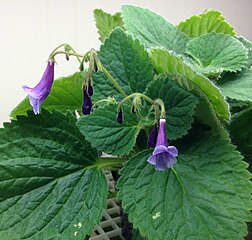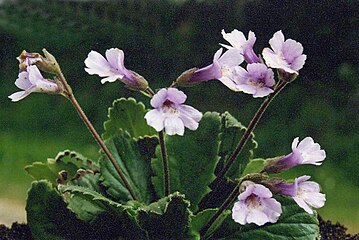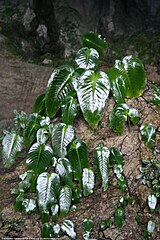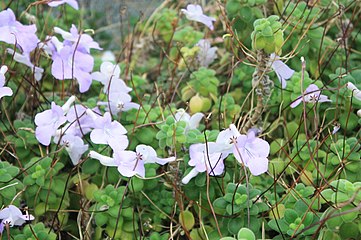
A cotyledon is a significant part of the embryo within the seed of a plant, and is defined as "the embryonic leaf in seed-bearing plants, one or more of which are the first to appear from a germinating seed." The number of cotyledons present is one characteristic used by botanists to classify the flowering plants (angiosperms). Species with one cotyledon are called monocotyledonous ("monocots"). Plants with two embryonic leaves are termed dicotyledonous ("dicots").

The Crassulaceae, also known as the stonecrop family or the orpine family, are a diverse family of dicotyledon flowering plants characterized by succulent leaves and a unique form of photosynthesis, known as Crassulacean acid metabolism (CAM). Flowers generally have five floral parts. Crassulaceae are usually herbaceous but there are some subshrubs, and relatively few treelike or aquatic plants. Crassulaceae are a medium-sized monophyletic family in the core eudicots, among the order Saxifragales, whose diversity has made infrafamilial classification very difficult. The family includes approximately 1,400 species and 34–35 genera, depending on the circumscription of the genus Sedum, and distributed over three subfamilies. Members of the Crassulaceae are found worldwide, but mostly in the Northern Hemisphere and southern Africa, typically in dry and/or cold areas where water may be scarce, although a few are aquatic.

Gesneriaceae, the gesneriad family, is a family of flowering plants consisting of about 152 genera and ca. 3,540 species in the tropics and subtropics of the Old World and the New World, with a very small number extending to temperate areas. Many species have colorful and showy flowers and are cultivated as ornamental plants.

Streptocarpus is an Afrotropical genus of flowering plants in the family Gesneriaceae. The genus is native to Afromontane biotopes from central, eastern and southern Africa, including Madagascar and the Comoro Islands. The flowers are five-petalled, salverform tubes, almost orchid-like in appearance, and hover or arch over the plant, while the pointed, elongate fruit is of a helical form similar to that of the "tusk" of a narwhal. In the wild, species can be found growing on shaded rocky hillsides or cliffs, on the ground, in rock crevices, and almost anywhere the seed can germinate and grow. For the home, there are now many hybrids of various colours and forms available.
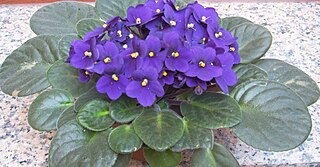
Streptocarpus sect. Saintpaulia is a section within Streptocarpus subgenus Streptocarpella consisting of about ten species of herbaceous perennial flowering plants in the family Gesneriaceae, native to Tanzania and adjacent southeastern Kenya in eastern tropical Africa. The section was previously treated as a separate genus, Saintpaulia, but molecular phylogenetic studies showed that it was nested within the genus Streptocarpus.

In botany, succulent plants, also known as succulents, are plants with parts that are thickened, fleshy, and engorged, usually to retain water in arid climates or soil conditions. The word succulent comes from the Latin word sucus, meaning "juice" or "sap".
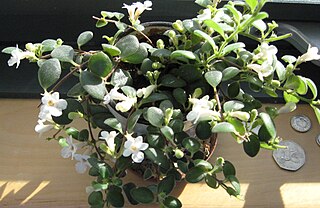
Codonanthe is a genus of mainly epiphytic plants in the family Gesneriaceae, endemic to the Atlantic Forest of Brazil. The botanical name comes from the Ancient Greek for 'bellflower'. They have white or pale pink flowers and somewhat fleshy leaves. In 2013, the genus was reduced in size when more than half of the species were transferred to Codonanthopsis. They can be grown as houseplants, particularly in hanging baskets. Artificial crosses with Nematanthus hybrids have produced the hybrid genus × Codonatanthus.

Cyrtandra is a genus of flowering plants containing about 600 species, with more being discovered often, and is thus the largest genus in the family Gesneriaceae. These plants are native to Southeast Asia, Australia, and the Pacific Islands, with the centre of diversity in Southeast Asia and the Malesian region. The genus is common, but many species within it are very rare, localized, and endangered endemic plants. The species can be difficult to identify because they are highly polymorphic and because they readily hybridize with each other. The plants may be small herbs, vines, shrubs, epiphytes, or trees. The genus is characterized in part by having two stamens, and most species have white flowers, with a few red-, orange-, yellow-, and pink-flowered species known. Almost all species live in rainforest habitats.

Streptocarpus rexii is a South African plant in the family Gesneriaceae, occurring widely from the southern Cape along the coastal hills, mountains, wooded ravines and valleys, and moist forests of the east coast, through Natal as far north as the Eastern Transvaal, up to an elevation of about 900 m. This genus of epiphytes and lithophytes, of about 130 species, is mainly African and Mascarene, with four vagrant species in Asia. Streptocarpus, as do other Old World Gesneriaceae, is unusual in that it displays anisocotylous or unequal growth, i.e. one cotyledon continues to grow after germination.

Calamoideae is a subfamily of flowering plant in the palm family found throughout Central America, South America, Africa, India, China, Southeast Asia and Australia. It is represented by 21 genera - containing nearly a quarter of all species in the palm family - including the largest genus, Calamus, the type genus of the group. Only four are found in the New World while the rest are Old World denizens, usually found in equatorial swampland or along tropical coastlines.

Haberlea is a monotypic genus of flowering plants in the family Gesneriaceae. The only member of this genus, Haberlea rhodopensis, is endemic to parts of Bulgaria and a small part of northern Greece, especially in the Rhodope Mountains. Common names include Orpheus flower and resurrection plant because of the remarkable ability of Haberlea to survive very long periods of desiccation.

Microchirita is a genus of flowering plants in the family Gesneriaceae, subfamily Didymocarpoideae.

The Gesnerioideae are a subfamily of plants in the family Gesneriaceae: based on the type genus Gesneria. Although genera typically originate in the New World, some species have become widely distributed as ornamental plants.
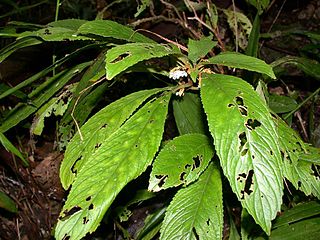
Rhynchotechum is a genus of plants in the family Gesneriaceae, subfamily Didymocarpoideae. Species distribution records are mostly from India, Sri Lanka, China through to southern Japan, Indo-China and Malesia through to New Guinea.
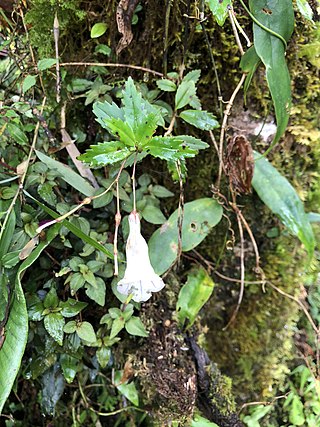
Lysionotus is a genus of flowering plants in the family Gesneriaceae. It occurs in the Himalayas, China, Japan, and Southeast Asia. The genus was described by David Don in 1822.
Tetraphyllum is a genus of flowering plants belonging to the family Gesneriaceae. As of April 2021, there was no consensus as to whether the correct scientific name for the genus is Tetraphyllum or Tetraphylloides, some sources using the former and some the latter.

Codonanthopsis is a genus of flowering plants in the family Gesneriaceae. Its native range is from southern Mexico through tropical America to Bolivia and most of Brazil. Codonanthopsis species are generally trailing epiphytes with pale flowers. Most have a mutualistic relationship with tree-living ants: the plants provide the ants with food, including nectar, and give their nests structure and support, while the ants disperse the plants' seeds. The genus was considerably expanded in 2013 when species were transferred from Codonanthe. Some Codonanthopsis species are cultivated as houseplants, when they may be grown in hanging baskets.
Coptocheile is a monotypic genus of flowering plants possibly belonging to the family Gesneriaceae. Its only species is Coptocheile macrorhiza. It is native to Brazil.

Fieldia is a genus of flowering plants in the family Gesneriaceae, native to New South Wales, Queensland and Victoria in Australia. It has at times been treated as monotypic, with one species, F. australis. Two are accepted as of April 2021 by sources that include Lenbrassia in Fieldia.
Oerstedina is a genus of epiphytic flowering plants in the family Gesneriaceae, native to Mexico, Costa Rica and Panama. The relationship of Oerstedina to the genus Rufodorsia is uncertain, as of April 2021.



